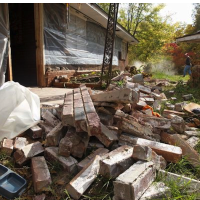California Loses Earthquake Crown to Oklahoma
 Oklahoma home damaged by 5.6 earthquake linked to fracking (photo: Sue Ogrocki, AP)
Oklahoma home damaged by 5.6 earthquake linked to fracking (photo: Sue Ogrocki, AP)
Oklahoma rocketed to the top of the earthquake charts in 2014, tripling the number of 3.0 shakers in California, the one-time undisputed champion of the United States.
But like the steroid scandal that tarnished baseball and ruined the statistical landscape in the 1990s, many scientists are pointing to the introduction of performance-enhancing chemicals to explain the recent 40-fold-plus increase in quakes—in Oklahoma’s case, hydraulic fracturing (fracking).
The Center for Investigative Reporting (CIR) crunched data from the U.S. Geological Survey (USGS) and counted 562 Oklahoma earthquakes with a magnitude 3.0 or greater, compared to 180 in California. E&E Publishing looked at the same numbers and counted 564, but who’s quibbling?
Oklahoma, a state half the size of California, only had 100 significant quakes the year before, and that was a huge leap from previous years. The state averaged 1-3 quakes a year from 1975 to 2008 before experiencing an uptick to 20 in 2009.
CIR says scientists lay the blame squarely on the oil and gas industry: “Numerous studies agree that wastewater disposal from hydraulic fracturing, or fracking, is a major factor in increasing seismic activity.” One of them, published last May in Science magazine, was entitled, “Sharp Increase in Central Oklahoma Seismicity Since 2008 Induced by Massive Wastewater Injection.”
Fracking is a drilling technique used to reach previously inaccessible deposits. High volumes of pressurized water force toxic chemicals, sand and other materials smashing through the Earth, then the stuff that bubbles back up to the surface injected back into the ground.
While the injection wells get most of the blame, fracking itself has been linked to quakes. CIR said Oklahoma, which has undergone an oil-drilling boom of late, pumped more than 50 billion gallons of wastewater back into injection wells last year.
North Dakota’s Bakken fields are the most heavily fracked in the country, and they have not experienced more earthquakes. But they aren’t near known earthquake faults; Oklahoma’s fracked fields are.
It’s possible that Kansas is feeling the effects of next-door neighbor Oklahoma’s new drilling activities. The state jumped from 2 to 42 in 2014, a 2,000% increase, with most of the quakes being near the Oklahoma border.
CIR said the conventional wisdom among scientists was that these induced quakes tend to be smaller than regular quakes occurring in nature, which is giving the USGS headaches. The agency uses quake data to quantify risks for use in shaping building codes and setting insurance rates.
Historical quake patterns along known or newly-charted fault lines are now being cluttered with man-made seismic activity. The USGS is in the process of reworking its hazard models even as scientists grope to understand the threat from fracking and injection wells.
But coincidence is not causality, and the science is still being developed, which leaves the door open for the oil and gas industry to deny any connection between fracking and quakes.
Catherine Reheis-Boyd, president of the Western States Petroleum Association, was outraged in March 2014 when Los Angeles City Council members voted to study whether a 4.4 earthquake was related to oil drilling. She called their behavior “irrational” and blamed it on “extremist environmental organizations.”
“The National Academies of Science and other geologists have already concluded the amount of energy involved in the process of hydraulic energy fracturing is far too small to trigger a felt earthquake. Moreover, despite the shrill and anti-science tone of much of the extreme opposition to hydraulic fracturing, this is a technology that has been used for more than six decades in California without any demonstrated harm to the environment, water supplies or anything else. It certainly has never been suspected of or linked to earthquakes in California.”
Critics say fracking has been linked to groundwater contamination, air pollution, releases of methane gas, sink holes and earthquakes.
As of January 31, Oklahoma had recorded 76 earthquakes of 3.0 magnitude or higher in 2015, compared with California’s 10.
-Ken Broder
To Learn More:
Hey, California: Oklahoma Had 3 Times as Many Earthquakes in 2014 (by Michael Corey, Center for Investigative Reporting)
Massive Spike in Okla. Earthquakes May Be Due to Fracking (by Max Ehrenfreund, Washington Post)
Shaken More Than 560 Times, Okla. Is Top State for Quakes in 2014 (by Mike Soraghan, E&E Publishing)
Sharp Increase in Central Oklahoma Seismicity 2009-2014 Induced by Massive Wastewater Injection (by K.M. Keranen, M. Weingarten, G.A. Abers, B.A. Bekins, S. Ge, Science)
Oklahoma Quakes This Year Top Tremors in California (by Marlena Baldacci and Mariano Castillo, CNN)
Fracking Earthquake Responsibility Case Goes to Court (by Noel Brinkerhoff, AllGov)
Oklahoma Earthquakes Blamed on Disposal of Fracking Waste (by Noel Brinkerhoff, AllGov)
- Top Stories
- Unusual News
- Where is the Money Going?
- Controversies
- U.S. and the World
- Appointments and Resignations
- Latest News
- Trump to Stop Deportations If…
- Trump Denounces World Series
- What If China Invaded the United States?
- Donald Trump Has a Mental Health Problem and It Has a Name
- Trump Goes on Renaming Frenzy






Comments